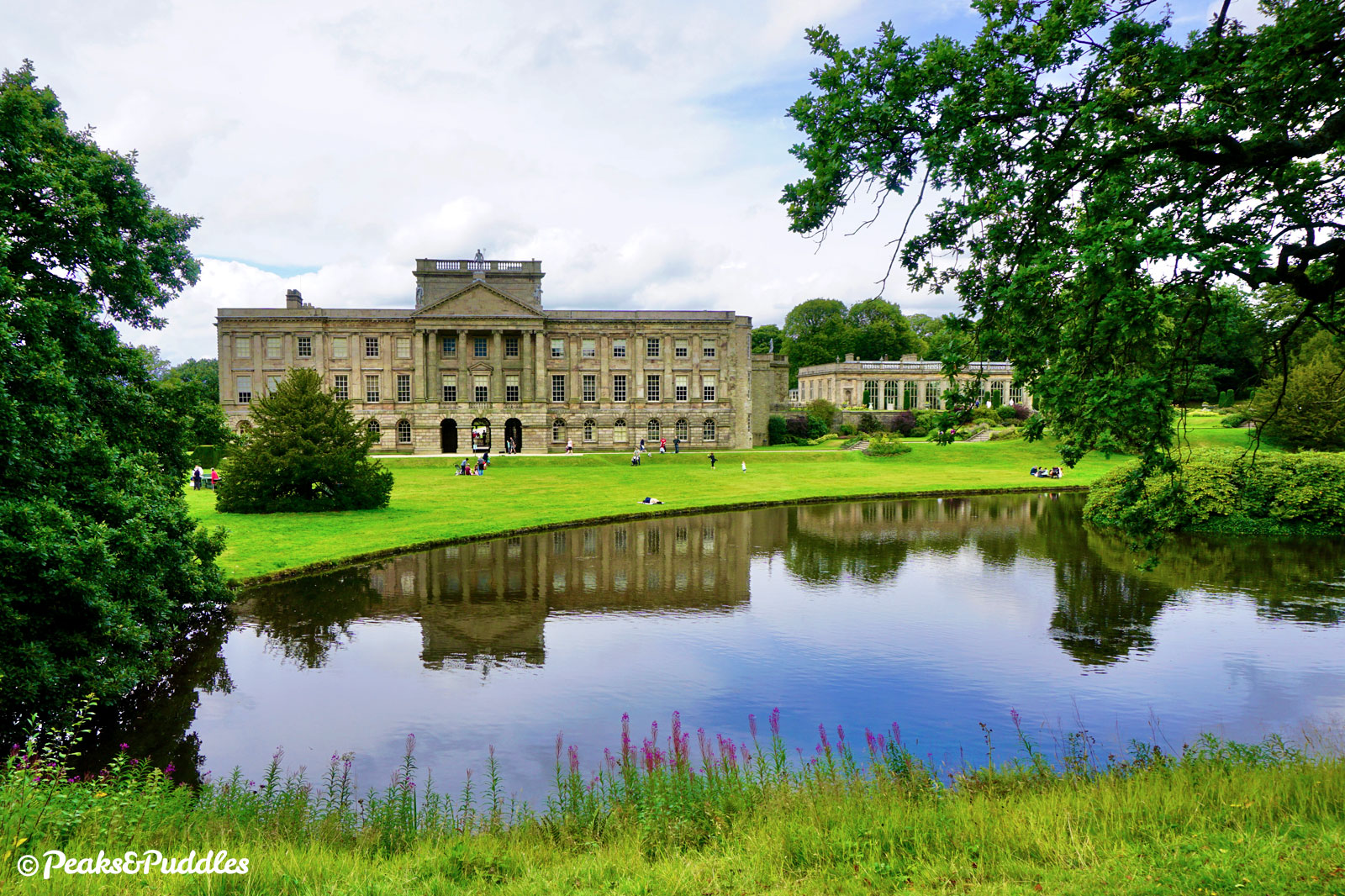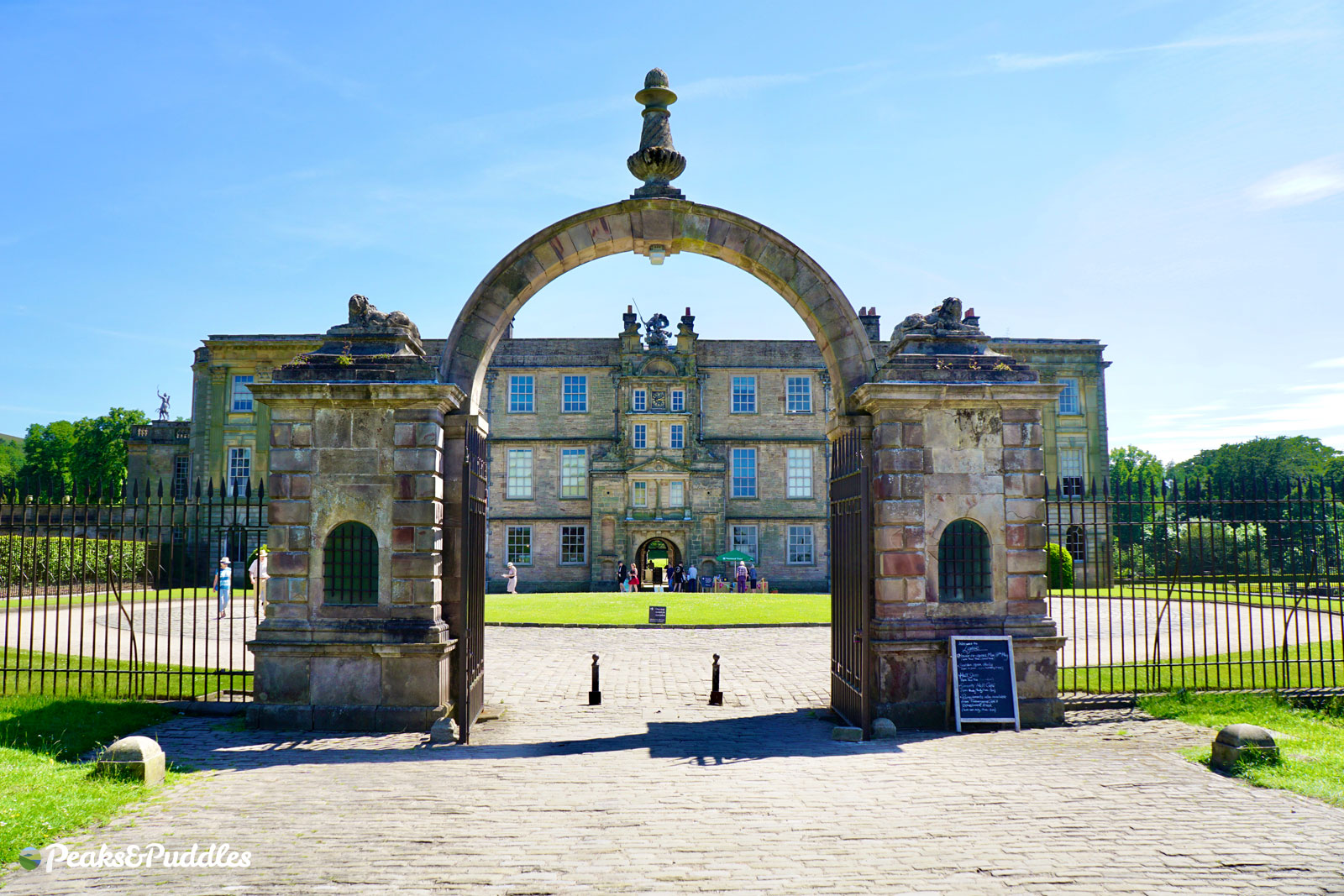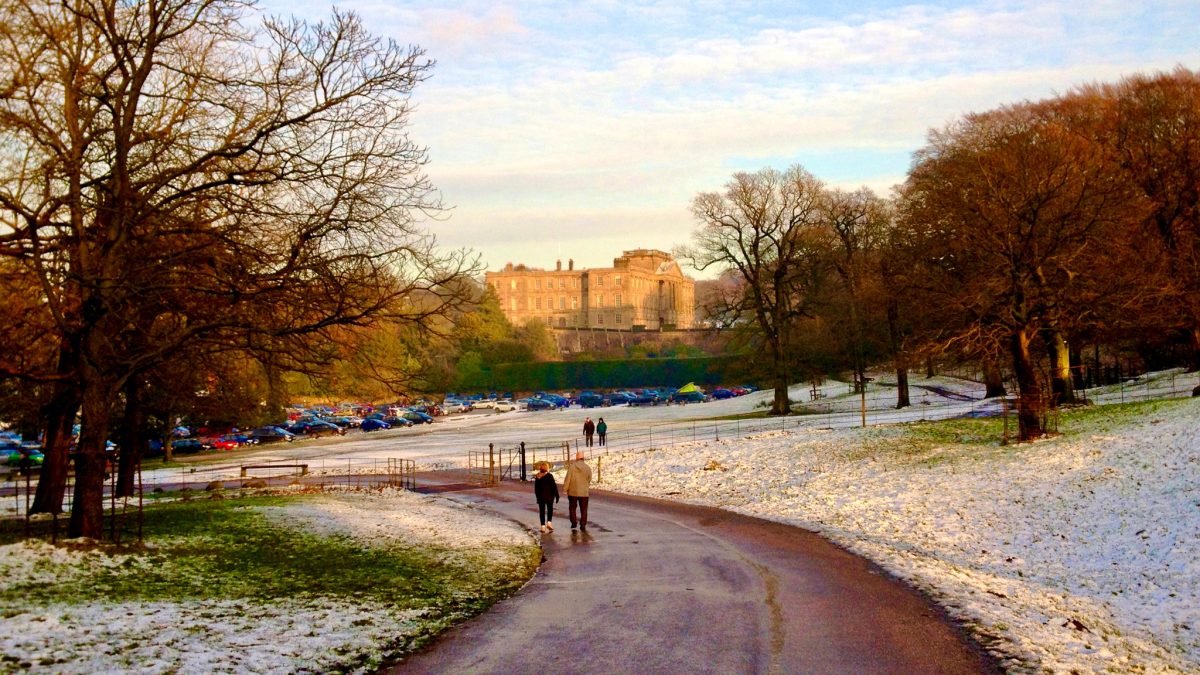From Middlewood Way to Lyme Park and on to the Peak Forest Canal, this near-perfect little loop always rewards. Traffic-free trails are joined by brief and mostly quiet roads around Marple, Poynton and Disley, with moderate climbs and beautiful views.
Route details
- Distance
 12.5 miles / 20.1 km
12.5 miles / 20.1 km - Elevation Gain
 215 m / 706 ft
215 m / 706 ft - Time allow 2 hours
- Difficulty
 Moderate
Moderate - Terrain 53% Off-Road Path Traffic-free trails, towpaths & cycleways 42% Road Quieter lanes, sometimes brief busier roads 5% Unpaved Bumpier tracks & bridleways
- Suited to
 All Bikes
All Bikes  Gravel Bikes
Gravel Bikes  Mountain Bikes
Mountain Bikes - Notes Just about suitable for road bikes with wider tyres but may still find the bumpy track up into Lyme tricky. A-frame barriers, narrow gates.
- Suggested Start Marple SK6 6HU SJ 9495 8868
- Places Cheshire, Cheshire East, Disley, Greater Manchester, Higher Poynton, Lyme Park, Marple, Marpleridge, Pott Shrigley, Rose Hill, Stockport, Strines, Turf Lea
- Attributes Accessible by train, Bridges, Canals, Car parking, Circular loop, Ideal for electric bikes, Industrial heritage, Mud and puddles, Museums and visitor centres, National Cycle Network, Pubs and cafés, Railways, Rewarding climbs, Rural heritage, Towns and villages, Views of hills and peaks, Views of open countryside, Woodlands and forests
Reputed to be the largest house in Cheshire, the Grade I-listed Lyme Hall sits splendidly on the edge of the Peak District in its 1,400 acre deer park. The estate entered the Legh family’s hands in the 14th Century, granted by Richard II, and remained there until the 20th Century.
Along the way, the 16th Century saw the bones of the present mansion house rise under Piers Legh VII, before the now recognisable Italianate frontage and courtyard layout took shape in the 18th Century.

The National Trust were gifted the estate in 1946 but it was managed by Stockport Corporation, and later Stockport Metropolitan Borough Council, as a country park until the trust took direct control in 1994.
As well as their familiar brand of gift shops and cafes, the trust have brought numerous major restorations. The library is a centrepiece with its 1487 Lyme Caxton Missal prayer book, bought by the National Trust in 2008; the oldest book in their entire collection.
Lyme is today Stockport and south Manchester’s closest boundary with the Peak District: this is where the National Park officially begins. For the thousands who pour out of the urban area to visit it each year, the history of the hall probably matters less than the fact it is simply a beautiful, special place to be.

Yet for those close enough to cycle, it can still feel like too much of a leap; bordered by the thundering A6 and otherwise accessed by a compass of poorly defined “footpath” routes which should have long ago been redefined for cycle access.
This route nevertheless cuts what is probably the best course for cycling through the park, showing how to easily link it with the Middlewood Way and Upper Peak Forest Canal. If you’d rather something a little more road-based, take a look at the equally enjoyable Lyme Lanes cycle route guide.
As well as being free to enter by bike, the unspoilt woods, moors and parkland are all surprisingly close to the modern day worlds of Marple and Disley, when you’re travelling by pedal power.
Route map
The route stats featured here are automatically generated by Komoot. For the most accurate guide, please refer to the route details above, based on actual rides recorded by Strava.
Getting there
One of the best things about this loop is that it feels truly circular: you could start or join almost anywhere and enjoy a rewarding ride. But Marple, at the furthest end from the key destination of Lyme Park, makes for the best beginning and this is the perfect route to first expand your horizons beyond the usual out-and-back along Middlewood Way.
The Macclesfield end of Middlewood Way or anywhere along the full Peak Forest Canal could also make for a reasonable start, while the Alan Newton Way provides an off-road link from inner Stockport to Rose Hill, where the mapped route begins.
By train: This route begins next to Rose Hill Marple railway station, with trains from Manchester Piccadilly, but also passes right by stations at Middlewood and Disley, with trains on the Buxton line via Stockport. All provide a perfect starting point.
By car: There’s free parking for Middlewood Way right at the start of the route on Railway Road, Marple. Other good parking spots are off Wood Lane, Marple, Nelson Pit (pay) or Shrigley Road at Higher Poynton or Disley railway station. What you save on the hefty car entry charge for Lyme Park can be spent on coffee and cake instead!
Things to note
- This route includes a long, essential section through the gates of Lyme, a National Trust property which is free to access on bike but only open certain hours (usually 9am to around 4.30pm or 8pm depending on time of year). Outside of these hours the route can’t be ridden in full at all, so do check the park’s opening times before setting off.
- Shrigley Road linking Middlewood Way to Lyme Park is relatively quiet and a good introduction to cycling beyond the trails onto country lanes. Just take care at the short, narrow tunnel under the canal to look and listen out for cars approaching from the other side (a front light may be advisable).
- The long, gradual climb into Lyme Park from West Park Gate is fairly bumpy and can be rather wet after rain, which is a shame for what could be a great, accessible car-free route into the park. That said, it’s still doable on most types of standard bike when tackled slowly uphill, as it is here.
- Two short lanes used to get in and out of Lyme Park are officially only footpaths as rights of way but otherwise private roads. In reality, they’re well used by thousands of cyclists each year without issue; maybe one day Cheshire East Council will properly reclassify these vital links.
- There’s no getting around touching the A6 for the briefest of moments in the centre of Disley, to connect Lyme Park with the Peak Forest Canal, but as you’re joining it from traffic lights then almost immediately making a left turn, it needn’t feel nerve-wracking even if you’re fairly new to main roads.
- See the Middlewood Way cycle route guide and Upper Peak Forest Canal cycle route guide for more things to note about these sections. Patience and a bell or friendly voice is essential for the canal towpath, not just when asking to pass people but approaching each overbridge. See more Tips for Cycling on Shared Paths.
Found this guide helpful?
Please consider chipping in the price of a coffee to help pay the bills and support my work. Or become a Peaks & Puddles Plus supporter to get access to exclusive routes and pages in return.
Route stage-by-stage
- From the start of the Middlewood Way on Railway Road at Rose Hill, Marple, join the former railway line and follow it for just shy of 4 miles (6 km). You start out on tarmac in a cutting beside the recycling centre and housing, then onto compacted stone to head out into the countryside, with views of rolling fields. At the old site of High Lane station, you pass under the A6 and into another damp cutting before arriving at Middlewood, where a higher station on this line to Macclesfield once connected with the now lonely platforms below. After passing under four old bridges, the next landmark is Higher Poynton station, with platforms still visible and picnic benches for a break before the slight climb ahead. Continue, passing under one more bridge.
- Approaching the car park for Poynton Coppice, leave the trail by the narrow access to the left (a second opening at the other side of the car park may be marginally wider), and turn right onto Shrigley Road. Rounding a sharp bend to the left, a sign immediately marks the start of Pott Shrigley parish, a renowned landscape for cycling on Cheshire’s edge of the Peak District. Follow the road around a few further bends past scattered houses and soon enough an unusual feature lies ahead: Red Acre Aqueduct on the Macclesfield Canal, which sits atop an impressive embankment. The road squeezes through what is effectively a single-file tunnel underneath, before immediately climbing briefly on the other side alongside a stream. After a parking lay-by, the road veers right and climbs up a narrow and surprisingly steep little hill to Green Close Methodist Church. Then, in a cruel twist after successfully climbing as far as the quaint stone chapel, turn a sharp left to travel back downhill to the west gate of Lyme Park.
- Beside West Lodge, an Edwardian gatehouse now turned holiday cottage by the National Trust, dismounting will be required to step through the awkward gate into West Park Drive. An old entrance track to the Lyme estate, this runs uphill through Hase Bank Wood. The track is bumpy and challenging in places, sometimes wet after rain and shared with many dog walkers, but scenic and atmospheric as you climb fairly strenuously up beside a brook. Near the top, as the track begins to level but still dotted with potholes, the banks are covered in a spectacular display of bluebells in May. Through a single gate at the top, the drive enters into the deer park itself at an area known as The Knott.
- Continue through the parking area and follow the now smoothly surfaced drive to the right, emerging from behind the grassy mound to see a stunning view over Manchester to the left and Lyme’s golden-hued Higher Moor to the right. Through a few dotted trees, the lane then drops swiftly downhill with a grand glimpse of Lyme Hall from its most famous angle: the Baroque-influenced south face redesigned by Italian architect Giacomo Leoni in the 1720s. More recently, of course, seen in the BBC’s classic adaptation of Pride and Prejudice, when Colin Firth emerged from the lake in the gardens. Rattle over a cattle grid and skirt around the attraction’s main car park. A stream on the left leads to the Timber Yard with a cafe and shop, while the information kiosk on the right has lighter refreshments and bike stands, if planning a visit the hall or garden (paid) or a free walk around the glorious parkland. Otherwise, work back up the small hill straight ahead.
- With Lyme Hall now on the right, turn left onto the main park drive and enjoy the reward of coasting gracefully downhill for exactly 1 mile (1.6 km) through the glorious parkland, surrounded by beautiful views. The prominent landmark of The Cage is soon visible on the right, a stone hunting lodge which has apparently also been variously used as a park keeper’s cottage and a lock-up for prisoners. If you’re particularly lucky, you might see the tower guarded by the park’s large but sometimes elusive herd of red deer, gathered majestically on the grassy bank. At the end of the descent, turn right at the small entry kiosk, being careful of any queuing cars, to climb briefly to another lodge house.
- Go through the gate onto Red Lane, gentle at first then a little bumpy as you climb a short hill and bounce over sharp speed humps between the enormous detached properties of Disley’s own Cheshire set. Turn left at the fork in the road to head downhill briskly with Disley coming into view — beware the sharp hidden speed hump near the bottom! Emerging into the cacophony of this busy village with the Ram’s Head pub to the left, join the queue for the traffic lights in the middle lane, ready to turn right. As the lights go green, be careful to wait for any vehicles coming down from Jackson’s Edge opposite, then turn right onto Market Street — aka the A6. As quickly as you joined, turn left immediately before the Dandy Cock pub ahead, down Hollinwood Road. This narrow lane tumbles past a row of stone cottages lost in time and under the Buxton railway line. Here, turn immediately left up a short ramp onto Hagg Bank Lane. Suddenly a panorama opens up over a different landscape entirely; Cheshire’s rolling fields replaced with the great hills of the High Peak on the other side of the River Goyt’s valley. With Hague Bar in the foreground, New Mills is nestled behind the hillside of Eaves Knoll, all dwarfed by the spectacular Kinder Scout in the distance and Chinley Churn to the right.
- After dropping down steeply on Hagg Bank Lane, turn right across the bumpy stone track to cross Higgins Clough Swing Bridge and then left onto the upper Peak Forest Canal towpath. Built to transport stone from the quarries around Peak Forest, the canal meanders gently along a level contour in the side of the ridge, with Cobden Edge the hilly landmark straight ahead across the valley, watching over all the way back to Marple. The towpath passes beside no less than three lift bridges and under three narrow stone bridges, as well as briefly forming the access drive to a property, just around the corner from where you joined. It’s no hardship being patient and taking it steady along this narrower shared path, one of the most picturesque stretches of canal towpath on the entire network. At Bridge 19, known as Brick Change Bridge, the towpath curves to the right up a tricky cobbled ramp (it may be advisable to dismount in advance) in order to change sides.
- After one final bend the canal arrives at Marple Junction, the top of the Marple Locks and where the Macclesfield Canal begins, beneath the bridge to the right. This can provide an obvious onward path, but comes with more cobbled ramps and steps, so instead the route ventures onto some quiet roads. Turn right over the bridge, then turn immediately left beside the toll house, around a barrier into the canal yard. Join Church Street then at the t-junction turn right onto Church Lane, followed by the first left into Mount Drive. Followgently downhill then back uphill where it becomes Ecclesbridge Road. Take the next right onto Barlow Crescent then, after heading back downhill, turn left onto Brook Drive. This leads to the busier Hibbert Lane, but it’s a case of merely turning right then immediately left to cross it, into the sedate Woodville Drive. A good descent for nearly half a mile (0.7 km) leads to a sharp right bend. Turn left at the post box into Wood Lane.
- Now back at Middlewood Way, turn right to rejoin the trail back to the starting point at Rose Hill. Or to loop around to Middlewood, Bollington or Macclesfield, turn left.
Found this guide helpful?
Please consider chipping in the price of a coffee to help pay the bills and support my work. Or become a Peaks & Puddles Plus supporter to get access to exclusive routes and pages in return.
Other route options
- For an alternative, more road-based loop through Lyme Park, swapping the trail and towpath featured here for Cheshire lanes and some of the best views in Greater Manchester, see the Lyme Lanes cycle route guide.
More to explore
- Marple
Once dominated by mills, now a leafy suburb of Manchester with canal locks, shops and refreshment stops.
The final stages of this route show a good quiet route between the Middlewood Way and the town’s locks. To visit the town centre, turn right after leaving the canal to head down Church Street, between the canal and the busier Church Lane. - Disley
Nestled between hills at the start of the High Peak but very much a Cheshire village with a good handful of pubs, access to Lyme Park and the Peak Forest Canal.
The route heads right through the village on the A6, which dominates slightly what is still a good pit stop.
Further reading
A Country House Christmas: Treasure on Earth by Phyllis Elinor Sandeman
The tales of an Edwardian Christmas at Lyme Hall, as told by members of the family.
Useful links
- Lyme
Official National Trust website with opening hours, visitor info and history.
Original photography, words and design by Anthony Sheridan unless indicated otherwise. Found this guide helpful? Buy me a coffee to help keep the wheels turning!
The all-important disclaimer: While great care and attention has been put into gathering these routes, ensuring details are accurate and determining their suitability, all information should be used as a guide only and is not a replacement for using your own judgement or research when setting out on new adventures. Peaks & Puddles/the author cannot be held responsible for any issues that may arise from the riders own decision to ride a section of indicated route.
Always ensure your equipment is safe and legal for use and that you are well prepared, carrying everything necessary including access to a good map. Follow the Highway Code and the Countryside Code at all times. Respect the landscape, the wildlife and the people you encounter. And after all that, have fun!














































































